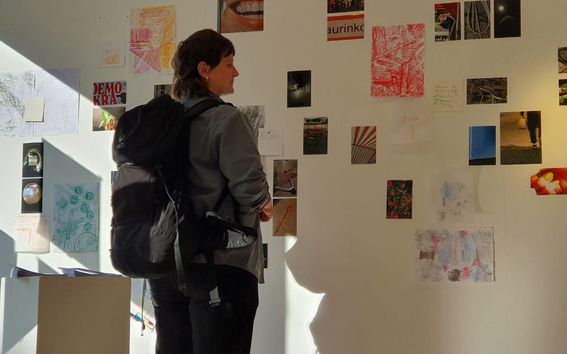ANTI-Festival presented three public space projects by Aalto art education students

The three public space projects "Joutomaa-Löytömaa" (Wasteland-Treasure land), "Outo aika" (Strange Hour) and "Kaupunkiluontoa luonnonväreillä" (Urban Nature in Natural Colours) by Aalto University art education students were presented at the ANTI-Festival of site-specific contemporary art.
In the Joutomaa-Löytömaa workshop, participants were invited to join city walks to explore forgotten places and their stories. On two different walks in the city centre and on the outskirts of the city, participants worked in groups to reflect on the past and possible futures of places. The workshop provided an opportunity to experience the city in a new way, sparking ideas about the environment.
A guided tour of the Outo aika workshop allowed participants to make observations of Kuopio at night. The excursion ended with a night time snack on the steps of the Kuopio Cathedral. During the excursion, participants wrote, drew and photographed their surroundings, thus gathering material describing and reflecting on the nocturnal world. The material was put together into a collective anonymous exhibition. In addition, a parallel audio work was recorded.
In the "Kaupunkiluontoa luonnonväreillä" workshop, participants made natural colours from plants found nearby. With the colours they had prepared, they painted on paper what they had found and felt.
The materials produced in the workshops formed finally an exhibition at the Kuopio Artists Association's gallery Ars Libera. The gallery also served as an important base during the festival.

The result of a long process
Aalto students started preparing for the festival already in spring as course work. "We had discussions and brainstormed the festival themes and thought together about what topics might be interesting. Elisa Itkonen, the executive producer of ANTI-Festival, also suggested suitable locations for our projects," says Minna Suoniemi, one of the teachers in charge of the course.
Cooperation with the ANTI Festival is not traditional student project work. The festival set the framework, but gave the students the opportunity to experiment and be creative in an artistic, pedagogical and participatory way, as equal partners.
"Aalto University has been working with ANTI-Festival for six years now, and over the years the collaboration has deepened. Now, for the second time, students designed and implemented their own projects, bringing a new perspective to the festival's programme. It has been a rewarding experience for both the students and the festival's audience," says Tomi Slotte Dufva, another teacher in charge.
"We try to build our projects around the festival's themes so that they resonate with the festival and its audience. This creates depth and meaning in the projects," says Slotte Dufva.

Taking project responsibility means learning to be an artist and producer
Johanna Mäkinen from the Joutomaa-Löytömaa project and Laura Vuoma and Lotta Aulamo from the Outo aika project say the festival was diverse and experiential.
"During the brainstorming phase of the workshops, we were able to think about what would be significant and what would interest people," says Mäkinen.
"It was important that the project felt like your own and that it would increase your own expertise."
"ANTI-Festival's own themes and courses in visual arts education served as starting points from which the workshops were built. Their ethos was reflected in the implementation and gave the workshops a pedagogical character", says Laura Vuoma. "Working with the festival gives students the opportunity to grow as artists. By taking responsibility for their own projects, students learn what it takes to be an artist and a producer at the same time", says Slotte Dufva.
The process intensified towards the end
The workshops were attended by a large number of local and international participants.
"Each of the three Joutomaa-Löytömaa workshops took a different direction and was therefore very interesting. We felt that the discussions with Laura Oja and the participants were good learning experiences and the feedback was positive. A few participants said that the activities introduced them to new things," says Johanna Mäkinen.
"We calculated that we were able to collect material produced by close to 100 participants during the festival week and display it on the gallery walls. It was fascinating to see how the walls were processively filled with the works and notes of different festival-goers of different ages in just under a week - and in the end they were all on display for just one weekend", says Lotta Aulamo of the Outo aika project.
"The process also included all sorts of other things during the week: evening walks, shared pizzas and beers, someone went swimming in a cold lake. I find such 'camp-like' and free, lived together projects terribly rewarding, unifying and emotional," says Aulamo.
"Things and encounters are fleeting and ephemeral, which is wistful but also palpable. These are the kinds of things that stay with you," she adds.
More information:
Lecturer Minna Suoniemi
[email protected]
Senior University Lecturer Tomi Slotte Dufva
[email protected]
Read more news

Get to know us: Associate Professor Maria Sammalkorpi
Sammalkorpi received her doctorate from Helsinki University of Technology 2004. After her defence, she has worked as a researcher at the Universities of Princeton, Yale and Aalto.
Aalto computer scientists in ICML 2024
Computer scientists in ICML 2024
Getting bacteria into line
Physicists use magnetic fields to manipulate bacterial behaviour






